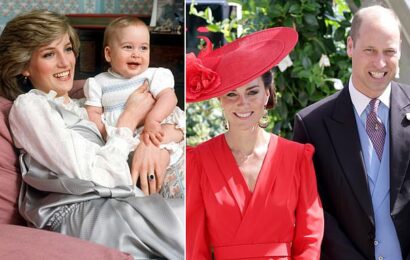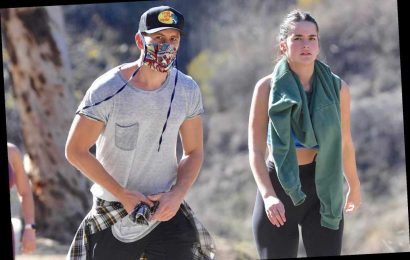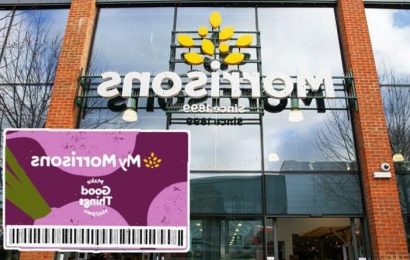Sometimes, as we muddle through the trials of family life, we are very grateful that there is no camera around to document our lows. But for YouTubers like Jamilla and Que, it is crucial to capture those very moments on video — not for vanity or fame, but because they have come to realize how much it helps others to share their everyday lives as Black lesbians raising their daughters, 3-year-old Harper and 3-month-old Holland, in Atlanta.
Since they started posting videos as a young engaged couple six years ago, their audience has grown to 29,000 subscribers who now tune in to watch them discuss their relationship, pregnancies, and everything from the typical toddler issues to why they decided to conceive their daughter with a friend as the sperm donor. Now, as members of the #YouTubeBlack Voices Fund Class of 2021, they’ll have help to make that audience — whom they call “Cousins” — grow even bigger.
When SheKnows caught up with Jamilla and Que, it was like turning one of their warm-natured, honest videos into real life (OK, Zoom life). They explained to us what it’s like to process raw emotions in real-time for the camera, how they’ll continue to do that when their daughters get older, and why it’s so worth it to them to do so. (Don’t miss our conversation with fellow Black Voices Fund recipient Ebony of Team2Moms.)
SheKnows: Congratulations on getting named to the Black Voices Fund. What does that mean for you?
Jamilla: The first word I think of is like validation. It feels really, really good to have been on the platform six years in March and to be a part of this program.
SK: Tell me about when you started. What made you decide to go on YouTube and what were your expectations back then?
J: I’d been obsessed with YouTube from the beginning, and when we were engaged, we didn’t see a lot of representation. To be Black and lesbian — I can’t turn on the television and just see my family, my stories, my life, what we were looking to do together. So we really wanted to be on the platform and create that space for others.
Que: It was Jamilla who really got me into the space. Once she showed me that there’s couples out here like us. I was like, oh, my God. Like, we have to do this. We have to show people our everyday lives. I felt like I was in a small little community once I’d seen other couples like us.
SK: Have you seen even more representation on the platform in the past six years?
J: Absolutely, yes. Not only do we see more of LGBTQ+ creators, there’s diversity [within that group].
Q: With us wanting to expand our family, there were more families that had already started and had already been through the process. In my whole pregnancy, I was able to watch families that had already gone through my process, so I knew in my mind, “OK, this is what’s going to look like once to have the baby.”
SK: Do you know who your audience is? Are they mostly LGBTQ families? Black families? Or do you also feel like you’re reaching people who are not like you at all?
J: I think we also have a lot of women who talk to us about their grandchildren, so maybe their grandchildren are gay or they’re looking to have a family, or maybe they’re not at all, and they just kind of relate with us on a on a human level.
Q: We’re wrapping up a series on our relationship, and I had a couple of people comparing some of our situations to what they went through with their husbands. Or a lot of single people feel like, “These are going to be good tips for when I start my family, or when I get married.”
https://www.instagram.com/p/CLNmDYrFdHA/
A post shared by Jamilla & Que (@jamillaandque)
SK: What do you think it would have meant for you when you were younger to see more people like yourselves represented on any kind of screen?
Q: I think for me, being masculine presenting, I think that would have helped me build more confidence and feel more secure with walking out of the house wanting to wear men’s clothes. Or going to school back in the day, like in high school, just seeing people who are like me that have succeeded. I think that would have like instilled so much in me growing up. And that’s why I’m hoping the example that I’m setting not only for my kids, but for other people on the platform that see us every day.
SK: How do you decide what to share about your personal lives?
J: At first, I thought, we’ll experience whatever’s happening, we’ll discuss it, and then we’ll share — so we would not share right in the moment. That changed when Que was pregnant and she chose not to share her pregnancy in real time.
Q: And I totally regret that now. That is something I wish I would have shared [in real time] because I had a high-risk pregnancy. I’m masculine presenting, and there’s so many people that message me now, asking, “How did you get pregnant? I’m scared about what people are going to think of me, being masculine. People think I want to be a man, but I want to carry a baby.” And I wish I would have documented that and dealt with those raw emotions on the camera, so I could have helped someone one day. Because during my pregnancy, I leaned on other families to help me with some of my questions, so I really regret that. So that’s why when Jamilla got pregnant, I said, “You have to go through everything on the camera.”
J: It was really tough because we were in the hospital, and I’m 36 weeks, and we get the news that we’re going to have to have the baby that day. I walked in because I couldn’t feel the baby moving, and I didn’t know what the solution was going to be. I just wanted to make sure she was OK. And they come in and they say, “You know, the baby’s going to be coming today.” And then your first thought is to process it. Then I’m like, “OK, I have to pick up the camera, because I could be helping someone else later on.” So if I process it myself, it helps our family, but if I’m able to do it on camera, I can touch maybe dozens, hundreds, thousands, ongoing.
SK: Does that make you process your emotions differently — thinking of yourself and your audience at the same time?
Q: Yeah. I remember just thinking about like that when Jamil was still coming out of her C-section, and I’m doing skin-to-skin for the first time, but I’m thinking, “Hey, I got to get something on camera.” I was extremely emotional, ready to bawl crying. But, I’m like, “OK, just be tough enough to be able to get some words out, and then deal with it once you put the camera down.” Because for me, I’m not a person that’s going to cry on camera. I’m just not going to do that unless you catch me in a raw moment.
J: And I like to process my feelings alone on my time, maybe weeks or months afterwards, so it really forced me to process. We were actually in the hospital for three days, and they told me that I had preeclampsia, and I didn’t know that I could have postpartum preeclampsia. And I was really sad because I thought I could go home with my baby, but I’m having to be in the hospital two or three more days. So I pick up the camera, I’m like almost in tears talking about how I’m worried about my health; I know that I’m a Black woman. I know the mortality rate of Black pregnant women. And I’m sitting in the hospital with high blood pressure. I don’t want to process this. I kind of want to go into a shell, but I need to put this out there.
SK: Well, thank you for doing that. How then are you going to deal with issues of Harper and Holland’s privacy? What kind of boundaries are you setting?
J: Harper sets her boundaries now. If we pull out the camera and she says, “Mama, no,” we put the camera down. We totally respect that. We call our community [on YouTube] “Cousins.” If we say, “Harper, say, ‘Hey, Cousins,’ and she goes, “No,” then that’s it. Our family is going to be first and foremost.
SK: What kind of conversations do you guys have with her about race and LGBTQ issues so far?
Q: She’s been having conversations early on, whether she understands it or not. She decided on her own, that this is Mama. I’m Mommy. And then she calls her dad Papi. Even with her going to daycare, you know, with people seeing their moms or grandmas pick up. She’s had questions.
J: So we picked her up and she goes, “That’s one of my classmates, and that’s her daddy.” And then she goes, “Well, who’s my daddy?” And I said, Your daddy is your Papi.” And she said, “Papi is my daddy. And I have Mama and Mommy.” And so we discussed what family is. I think although these are huge, complex ideas, but at the bottom of it is love, and you can make it very simple in that format. And so we just tell her, “You have a lot of love around you. You have people with a lot of people who love you, and your family’s just a little bit different than other people’s.”
Q: We make sure, like, Jamilla and I are still affectionate, so this is normal to her. We have gay guys that are our friends, my best friend is a gay guy. So there’s no limit on like what she will see as affectionate. She’ll see my parents, a man and woman, Jamilla and I, and then my best friend and his partner. So she sees all type of affection.
SK: Do you do you have plans for what you’re going to what kind of conversations are going to have if someone starts talking negatively about her family?
J: We still have those conversations now that tell her that there are going to be some people who don’t agree with it. And she doesn’t understand that concept yet. But I think it’s just like with me: I didn’t know who my biological father was growing up, but there was never this huge conversation, PSA special about Who Is Jamilla’s Father. It was something I always knew. And I knew that the man who raised me was not my biological father, but he was my father in love. So I think when you have these complex conversations early on, you just break them down real simple. And the more they understand, the more you add on.
SK: What’s coming next for you, other than, you know, raising a toddler and a baby?
Q: I want to vlog more about the balance of two kids and integrating Holland into this life. She’s already had three photo shoots! For me, I’m just really pushing the masculine-presenting agenda, just letting people know: It’s OK to wear men’s clothes and still be feminine. You don’t have to go with the misconception of people thinking, “Oh, she wears men’s clothes. She wants to be a man.” Because that’s just totally never been my situation, and I know there’s a lot of women out there like me. So I’m making sure that my content helps them the way I wish I had when I was growing up.
J: I think also on the channel, we’re doing a lot of more series format where we’re really sitting down and having conversations. What I want to keep talking about is postpartum. I don’t have postpartum depression, thankfully, but I have the anxiety. So I’ve been talking about that, because I don’t believe that’s talked about enough. Also, being a black woman who is a lesbian, and how that that appears in health care, how doctors and nurses interact with me and the kind of questions that we have to go through —those are the kind of topics I just want to keep talking about.
SK: We’re looking forward to watching you do that!
Add these beautiful children’s books by Black authors and illustrators to your kids’ shelves.
Source: Read Full Article








